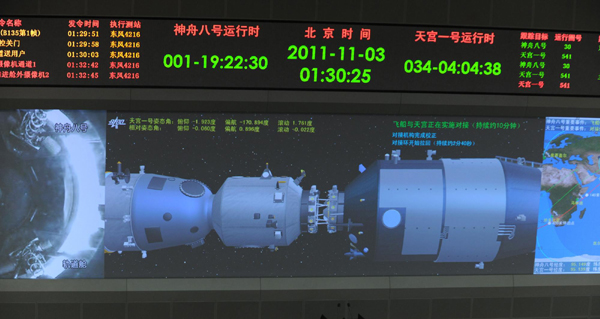China makes major leap with space docking
Updated: 2011-11-03 19:45
(Xinhua)
|
|||||||||||
 |
|
In this video grab taken from the China Central Television on Nov 3, 2011, a 3D animation of China's Shenzhou VIII spacecraft docking with Tiangong-1 space lab module is shown on a screen at the Beijing Aerospace Control Center in Beijing, capital of China, Nov 3, 2011. [Photo/Xinhua] |
BEIJING - The successful docking of the unmanned spacecraft Shenzhou VIII with the space lab module Tiangong-1 on Thursday is a major technological breakthrough for the country, a spokeswoman for China's manned space program said.
At 1:36 am Thursday, Shenzhou VIII, which was launched two days earlier, successfully rendezvoused and docked with Tiangong-1 target module, spokeswoman Wu Ping told a press conference. The country has never before joined two spacecraft together in space.
Tiangong-1, an unmanned module of a planned space lab, has been in orbit since its launch on September 29.
Equipment has been working properly since the successful docking and the coupled spacecraft have already orbited Earth nearly six times, Wu said.
Shenzhou VIII and Tiangong-1 will fly together for about 12 days and then conduct another space docking at an appropriate time, Wu said.
Through more than 10 years of efforts, China has made breakthroughs in key technologies and formed a set of design, production and experiment systems for spacecraft space docking, Wu said.
"Acquisition of the space docking technology is vital for China to implement the three-phase development strategy of its manned space program and to promote the sustained development of its manned space cause," she said.
Space docking is among the fundamental technologies necessary for manned space operations, according to Wu.
The precision docking system and also the over 600 sets of equipment aboard Shenzhou VIII are all developed and made by China, Wu said.
The docking system, composed of up to 10,000 parts, was developed by Chinese research institutions led by the Shanghai Academy of Spaceflight Technology, she added.
Future plan
Shenzhou VIII, launched by a Long March 2F/Y8 rocket at 5:58 am Tuesday from Jiuquan Satellite Launch Center, is set to return to Earth on the evening of November 17, Wu said.
She said China will complete the second step of its three-phase development strategy for its manned space program by establishing its own space lab around 2016.
China's spacecraft will conduct two more space docking missions in 2012. After that, the nation will begin to build a space lab and space station.
The country will establish a manned space station around 2020, Wu said.
Int'l cooperation
The spacecraft Shenzhou VIII has an experiment device installed which Chinese and German scientists will carry out joint life-science experiments with, Wu said.
It is the first time China's manned space project will carry out international cooperation in the field of space science application, she said, adding that the cooperation between the two sides was "very good."
A total of 17 life-science experiment projects will be conducted via the loaded device, including 10 Chinese projects, six German projects, and one jointly-developed project.
China and Germany signed an agreement in May 2008 to make concerted efforts to conduct life-science experiments during the Shenzhou VIII space mission, according to Wu.
China will continue with international exchanges on the basis of mutual respect, win-win cooperation, transparency and opening-up in constructing space labs and space stations, Wu said.
Furthermore, the module Tiangong-1 also carried with it several scientific experiments, including those on remote sensing, space material science and space environment, she said.
Related Stories
Shenzhou VIII nears Tiangong-1 for space docking 2011-11-02 18:43
Shenzhou VIII off to rendezvous in space 2011-11-01 08:04
Unmanned spacecraft Shenzhou VIII blasts off 2011-11-01 07:37
China says launch of Shenzhou VIII successful 2011-11-01 07:01
Hot Topics
Libya conflict, Gaddafi, Oil spill, Palace Museum scandal, Inflation, Japan's new PM, Trapped miners, Mooncake tax, Weekly photos, Hurricane Irene
Editor's Picks

|

|

|

|

|

|







